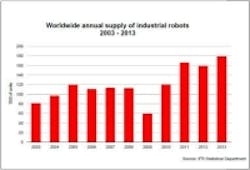Robotics industry report shows record growth for in 2013, high hopes for 2014
Earlier this year, The International Federation of Robotics (IFR) released a report that predicted worldwide sales for industrial robots would reach 168,000 units for 2013. At the AUTOMATICA Conference on June 4, however, IFR President Arturo Baroncelli reported that 179,000 robots were actually sold, and that incoming orders in 2014 are on the rise.
The record-breaking 179,000 figure represents a large increase over the 159,000 sold in 2012, which represented the second highest amount ever sold. Sales of robots reached record levels in nearly all regions. A summary of each individual market is as follows:
- Asia/Australia: Almost 100,000 robots were sold in 2013, 18% more than 2012.
- China: Almost 37,000 robots were sold in 2013. Annual sales in China have increased by 36% on average from 2008-2013.
- Japan: Approximately 26,000 robots were sold in 2013, a 9% decrease from 2012 as a result of reduced investments in the automotive/electronics industries.
- Korea: More than 21,000 robots were sold in 2013, 10% more than 2012.
- Europe: More than 43,000 robots were sold in 2013, 5% more than 2012.
- Germany: More than 18,000 robots were sold in 2013, 4% more than 2012. . Between 2008 and 2013, robot sales to Germany increased by 4% on average.
- Africa: More than 700 robots were sold in 2013, 87% more than 2012.
- United States: Almost 24,000 robots were sold in 2013. Annual sales in the US have increased by 12% on average from 2008-2013 as a result of increased adoption of automation technologies.
Japan, Korea, Germany, and the United states represent 50% of total sales volume in 2013. In addition, the following countries saw positive growth in 2013: Taiwan, India, Indonesia, Italy, Spain, Mexico, and Canada.
The main drivers of robotic sales growth for the year were the automotive (5% growth in 2013) and metal industries (17% growth in 2013). Between 2010 and 2013, these industries have led to a 22% increase on average, according to the IFR. The main countries accounting for this growth were China, Germany, and the United States. In addition, robot investments increased in the following industries: Food and beverage, pharmaceutical, and electronics.
This trend toward global automation, according to the IRF, is aided by the following:
- A need for energy efficiency and the use of new materials
- Global competitiveness and the need for increased productivity and high quality
- Growing consumer markets
- Decreasing life cycles of produces and increasing variety of products
- Robots improving the quality of work by taking over dangerous, tedious, and dirty jobs
Furthermore, the IFR estimates that worldwide sales for industrial robots will reach 200,000 units in 2014, which represents a 12% gain over an already record-breaking 2013.
View the press release.
Also check out:
Researchers develop robotic arm that can catch fast moving
Personal companion robot reads human emotions
Companion robots: Start of something big?
Share your vision-related news by contacting James Carroll, Senior Web Editor, Vision Systems Design
To receive news like this in your inbox, click here.
Join our LinkedIn group | Like us on Facebook | Follow us on Twitter | Check us out on Google +
About the Author

James Carroll
Former VSD Editor James Carroll joined the team 2013. Carroll covered machine vision and imaging from numerous angles, including application stories, industry news, market updates, and new products. In addition to writing and editing articles, Carroll managed the Innovators Awards program and webcasts.

